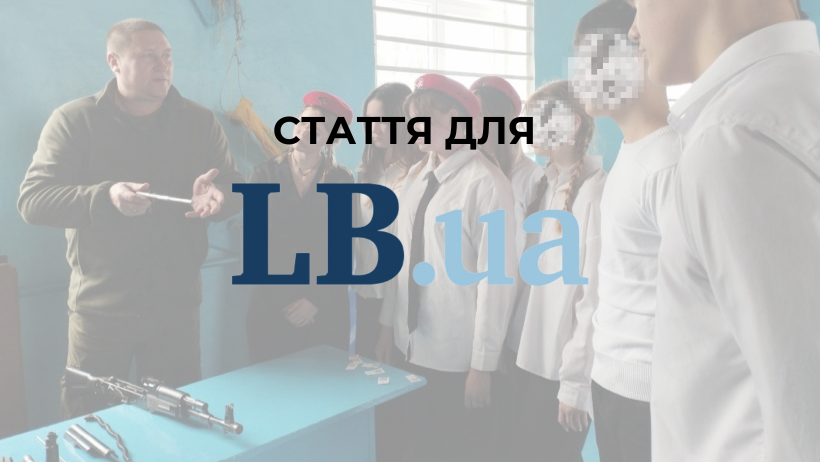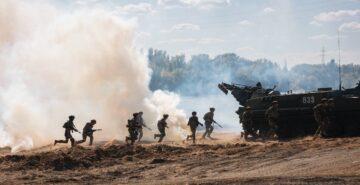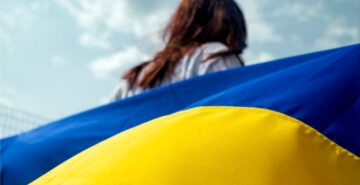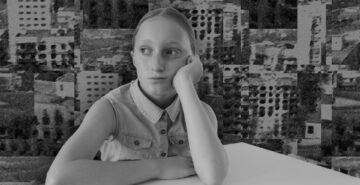

What norms of international law does Russia violate by indoctrinating and militarising Ukrainian children in the TOT?
Authors: Tetiana Lychko and Olha Shapoval, documentarians of CCE “Almenda”
Russia pays special attention and efforts to the “education” of children in the temporarily occupied territories of Ukraine (hereinafter − TOT). Russia’s goal is to completely destroy the Ukrainian identity of children, to Russify and militarise them, so that they become “true patriots” ready to defend “their homeland”. For this purpose, Russia has built a whole system that is present in all spheres of children’s lives, starting from preschool age. The NGO “Centre for Civic Education “Almenda” has been recording Russia’s actions in relation to children in the TOT since 2014. In this article, the organisation’s experts are providing facts and important figures on the indoctrination and militarisation of children, which are considered as violations by the Russian Federation of a number of norms of international law and international humanitarian law.
Lack of access to Ukrainian education
The Russian occupation authorities in the TOT of Ukraine have completely changed the education system, forcibly transferring it to Russian standards. In the TOT of Zaporizhzhia and Kherson regions, since 01.09.2023, education has been conducted in Russian language, and the study of Ukrainian as a mother tongue is allowed, de jure, only as an optional course.
There is also a significant decrease in the number of educational institutions with Ukrainian as the language of instruction in the TOT of Crimea:
- In 2013-2014 there were 7 schools with Ukrainian as the language of instruction, 76 schools with Ukrainian and Russian as the languages of instruction, 829 classes with Ukrainian as the language of instruction. 12,694 students studied in these schools and classes with Ukrainian as the language of instruction (it was ensured that 100% of students in the Autonomous Republic of Crimea were studying Ukrainian language and literature).
- In 2023 there was 1 school with Ukrainian as the language of instruction and 1 class with Ukrainian as the language of instruction in a Russian language school. In total there were 197 students in these classes.
There has been a decrease in classes even compared to the 2021-2022 school year, in which, according to the occupation authorities, there were 2 classes with Ukrainian as the language of instruction in a Russian language school
These actions constitute a violation of Article 29 of the Convention on the Rights of the Child, to which the Russian Federation is also a party: “…the education of the child shall be directed to: (c) The development of respect for the child’s parents, his or her own cultural identity, language and values, for the national values of the country in which the child is living, the country from which he or she may originate, and for civilizations different from his or her own…”; and Article 50 of the Geneva Convention relative to the Protection of Civilian Persons in Time of War: “The Occupying Power shall, with the cooperation of the national and local authorities, facilitate the proper working of all institutions devoted to the care and education of children.”
Patriotic and militaristic youth movements as a tool for re-education and militarisation of children
Russia has created dozens of children’s and youth movements that reach out to children in the TOT, starting from their preschool age. The first youth movements appeared in 2014 in the TOT of Crimea. For example, the prototype of the current “Movement of the First”, the movement “Nashi” (Russian for “Ours”), “Bolshaya Peremena” (Russian for “Big Shift”) and others.
With the expansion of the geography of the Russian-occupied territories, in 2022 the influence of these movements on other Ukrainian territories expanded. Children’s and youth movements are used by the Russian occupation authorities as another tool for re-education of Ukrainian children, mostly in educational institutions. Patriotic education conducted by Russian youth organisations is part of the Russian state policy, as stated in strategic documents and relevant legislation, in particular, the federal law “On Education”. According to this law, the “Movement of the First”, as an organisation (established in 2022) that brings together other youth and children’s movements, is to contribute to the implementation of the state youth policy and the education of children in accordance with “Russian traditional values”.
Development dynamics of the “Movement of the First”


The “Movement of the First” is actively working to impose Russian identity on Ukrainian children. In particular, the opening of the movement’s primary branches in educational institutions is accompanied by the active use of Russian symbols, listening to Putin’s speeches and Russian propaganda narratives. The movement is also actively engaged in legitimising the Russian invasion of Ukraine.
According to the officials of the occupation administration of Kherson region, the development of youth organisations in Kherson region will accelerate the process of integration of the region into the Russian Federation and provide “prospects for young residents of the new constituent entity of the state” (i.e. the Russian Federation). Therefore, the occupation authorities spare no resources to promote and open branches of various youth organisations, movements, etc.
In particular, the dynamics of the ‘Movement of the First’: TOT Crimea – 300 branches in May 2023, 503 branches in October 2023; TOT of Sevastopol – almost 300 participants in June 2023 and already more than 10 thousand participants in February 2024; TOT of Zaporizhzhia region – 1200 participants/67 branches (March 2023), more than 7000 children/194 branches (December 2023); TOT of Kherson region – 58 branches in April 2023, 59 branches /600 children (May 2023) and already 960 children as of July 2023.
The ‘Movement of the First’ is actively working to impose Russian identity on Ukrainian children. In particular, the opening of the movement’s primary branches in educational institutions is accompanied by the active use of Russian symbols, listening to Putin’s speeches and Russian propaganda narratives. The movement is also actively engaged in legitimising Russia’s invasion of Ukraine. For example, it is under the patronage of the ‘Movement of the First’ that children create amulets for members of the so-called ‘Special military operation’. Russian propaganda narratives are also disseminated at school events – the movement’s members call the occupation of Ukrainian territories by Russia ‘annexation’ and praise further life as part of a ‘great and strong Russia’.
In the TOT of Kherson and Zaporizhzhia regions, the Russian Federation is actively developing a network of the youth movement “Yug Molodoj” (Russian for “Young South”), which has at least 17 branches and more than 7,000 members. The movement is actively indoctrinating children and youth, including through conducting game events and organising celebrations for the so-called “Day of Reunification of Kherson Region with Russia”. Activists of the movement encourage children and youth of the TOT to cover with paint the colours of the Ukrainian flag and coat of arms, explaining these actions by the presence of “Nazi symbols”, and instead draw Russian tricolours (the “Paint the Future” campaign).The establishment of branches of such organisations in the occupied territories to educate children in the spirit of “Russian patriotism” may be regarded as a violation of Article 43 of the Hague Convention and Article 50 of the Convention relative to the Protection of Civilian Persons (in the context of the proper working of all institutions devoted to the care and education of children). In addition, patriotic education aimed at fostering Russian identity poses a direct threat to the right of a child to preserve his or her own identity (Article 8 of the Convention on the Rights of the Child).
.
Read more about the activities of youth movements in the TOT in the report “Youth Movements as an Instrument of Indoctrination and Militarisation in the Occupied Territories” prepared by of the Centre for Civic Education “Almenda”.
New educational programmes which involve moving children from the TOT to Russia
After the start of Russia’s full-scale invasion and occupation of new territories of Ukraine, new educational programmes and tools were developed and implemented to destroy Ukrainian identity through the use of education, one of which is the programme “University Sessions”.
The programme provides for the short-term transfer of children of high school age (starting from the age of 14, and in some cases from the age of 12) from the TOT of Kherson, Zaporizhzhia, Donetsk, Luhansk and Kharkiv regions to higher education institutions in Russia. The aim of the programme is career guidance and the formation of a Russian identity, and de facto, the Russification of Ukrainian children, the erasure of Ukrainian identity and the stimulation of their relocation from the occupied territories for their study and further residence in the Russian Federation.
From the start of the programme in June 2022 until December 2023, the “University Sessions” reached more than 20,000 Ukrainian children aged 12 to 17, and 81 universities from 47 Russian regions participated in it. The program “University Sessions” was personally patronised by the President of the Russian Federation Vladimir Putin and its implementation was discussed at the highest levels of the Russian Federation.
Russia’s implementation of the program “University Sessions” contravenes international law, in particular the 1989 Convention on the Rights of the Child, Article 49 of the Geneva Convention relative to the Protection of Civilian Persons, and Article 43 of the Hague Regulations. According to Article 43 of the Hague Regulations, the Russian occupation authorities do not have the authority to implement Russian federal legislation, but instead must respect the laws that were in force in the territory before the occupation. The Occupying Power must also “in cooperation with the State and local authorities, promote the proper functioning of institutions responsible for the care and education of children”. Article 8 of the 1989 Convention on the Rights of the Child, to which the Russian Federation is also a party, states that the child has the right to preserve his or her identity, including national identity.
More details can be found in the analytical report “The “University Sessions” program as the instrument for the indoctrination and destruction of the Ukrainian identity of children and youth from the temporarily occupied territories”.
Militarisation, military training, recruitment of young people in the TOT
Article 50 of the Geneva Convention relative to the Protection of Civilian Persons in Time of War prohibits the Occupying Power from enlisting children in formations or organizations subordinate to it, including those pursuing political aims. Article 20 of the International Covenant on Civil and Political Rights states that any propaganda for war shall be prohibited by law. Article 38 of the Convention on the Rights of the Child and customary international humanitarian law prohibits the recruitment or use of children under the age of 15 as soldiers or allowing them to take part in hostilities. Conscripting or enlisting children under the age of 15 into the national armed forces or using them to participate actively in hostilities constitutes a war crime under Article 8(2)(b)(xxvi) of the Rome Statute of the ICC. Both Ukraine and the Russian Federation, having ratified the Optional Protocol to the Convention on the Rights of the Child on the involvement of children in armed conflict, have undertaken to take all possible measures to ensure that persons under the age of 18 do not take a direct part in armed conflict.
Для вербування дітей на ТОТ України РФ, зокрема, використовуються такі інструменти як мілітаризації освіти, «відпочинок» у воєнно-патріотичних таборах, членство в «Юнармії» та інших військово-патріотичних рухах, а саме:
- To recruit children in the TOT of Ukraine, the Russian Federation, in particular, uses such tools as militarisation of education, “recreation” in military-patriotic camps, membership in the “Youth Army” and other military-patriotic movements, namely:
- from 1 September.2023, schools began to teach a course of basic military training as part of the subject “Basics of Life Safety”, during which children are taught the basics of shooting, rules for handling weapons and personal protective equipment, the use of hand grenades, drill and engineering training, as well as first aid. The organizers also “help children to get an idea of service in the armed forces of the country” (i.e., the Russian Federation) in order to prepare future defenders of the homeland (i.e., the Russian Federation). And starting from 1 September 2024, the subject “Basics of Life Safety” will be renamed “Basics of Security and Defence of the Motherland”. Therefore a new federal programme was approved in the Russian Federation and it is planned to involve participants of the so-called special military service in teaching this subject;
- increase in the number of cadet classes in the TOT of Crimea and their opening in the so-called “new territories”: in the TOT of Crimea, there are already 64 schools with cadet classes in the 2023-2024 academic year; in the TOT of Zaporizhzhia region, 5 cadet classes were opened by the end of 2023; in the TOT of Kherson region, there are at least 4 classes (September 2023);
- children from the TOT of Crimea, the city of Sevastopol, Kherson and Zaporizhzhia regions are involved in the youth organisation “Youth Army”, where they get basic military training, and some of them later become members of the armed forces of the Russian Federation and take part in the war against Ukraine. Members of the “Youth Army” are: more than 11,243 children in the TOT of Crimea, more than 14,500 in the TOT of the city of Sevastopol (April 2023), several hundreds in the TOT of Zaporizhzhia region (February 2024), more than 600 in the TOT of Kherson region (February 2024). By the end of 2024, 10% of schoolchildren in the TOT of Crimea are expected to join the ranks of the “Youth Army”;
- participation of Ukrainian children in military-patriotic training camps/games organised by the School of Young Commanders and the School of Future Commanders, which are implemented by the Krympatriot Centre and the Youth Army in the TOT of Crimea and Sevastopol, where children learn the basics of military tactical and engineering training, field medicine, etc. Such events are held regularly in the TOT of Crimea and Sevastopol. In addition, in the summer of 2023, the military field training camp “Crimean Frontier” was organised for Ukrainian children in the form of a tent camp, which was held in 5-day shifts throughout the summer. In total, 11 shifts were held, with at least 600 children from the TOT of Crimea and Kherson region participating.
.
By such actions, the Russian Federation is actually recruiting children from the TOT of Ukraine to serve in its army or other military groups. The acquisition of Russian citizenship by Ukrainian children from the TOT serves as a springboard for this. And youth movements, in particular, are actively involved in awarding Russian passports. Moreover, the amendments to the Federal Law “On Military Duty and Military Service” introduced on 14.04.2023 allowed citizens who have reached the age of 18, i.e. immediately after graduating from secondary school, to sign a contract for service in the Russian Armed Forces.
Therefore, we can state that after the full-scale invasion, Russia’s illegal policy towards children has only intensified and spread to new occupied territories in order to accelerate the integration of these territories of Ukraine and their population into the Russian Federation. And the lack of an adequate international response to the above violations leads to the fact that the Russian Federation continues and increases its influence on Ukrainian children from the TOT, violating a number of norms of international law and international humanitarian law.
The article was prepared by the Centre for Civic Education “Almenda” as part of the project “Childhood Unchained: Standing Against Occupation`s Impact”. The project is implemented with the financial support of the Ministry of Foreign Affairs of the Czech Republic as part of the Transition Promotion Programme. The views expressed in this report are those of the authors and do not reflect the official position of the Ministry of Foreign Affairs of the Czech Republic



